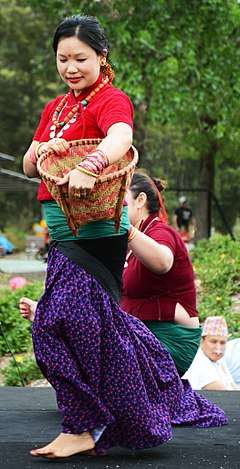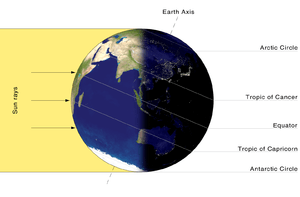Maghe Sankranti
| Maghe Sankranti | |
|---|---|
 Basket dance at Maghe Sankranti | |
| Observed by | Hindus, Nepal |
| Type | religious, cultural |
| Significance | welcome longer days, sun worship |
| Date | almost always 14 January |
| 2017 date | 14 January |
| 2018 date | 15 January[1] |
| Related to | Makar Sankranti |
Maghe Sankranti (Nepali:माघे सङ्क्रान्ति, Mathili:माघि, Nepal Bhasa:घ्यःचाकु संल्हु) is a Nepalese festival observed on the first of Magh in the Vikram Sambat (B.S) calendar (about 14 January) bringing an end to the winter solstice containing month of Poush. Maghe Sankranti is similar to solstice festivals in other religious traditions.[2]
Observant Hindus take ritual baths during this festival, notably at auspicious river locations. These include Sankhamul on the Bagmati near Patan; In the Gandaki/Narayani river basin at Triveni, Devghat near Chitwan Valley and Ridi [3] on the Kaligandaki; and in the Koshi River basin at Dolalghat on the Sun Koshi. Festive foods like laddoo, ghee and sweet potatoes are distributed. The mother of each household wishes good health to all family members.
Date and significance
Generally makar sankranti falls on 14 January, and is called Makar Sankranti or other names in the Indian subcontinent. Maghe Sankranti is a major harvest festival celebrated in Madhesh and Tharuhat of Nepal. The movement of the sun from one zodiac sign into another is called Sankranti and as the Sun moves into the Capricorn zodiacal sign known as Makara, this occasion is named as Makara Sankranti in the Pahari context. It is one of the few Nepalese festivals of Madhesi and Tharu people that are celebrated on a fixed date, i.e., 14 January because this solar festival in the honor of deity Surya follows the solar cycle of the Bikrami calendar, unlike other festivals that follow lunar cycle.[4][5]
Maghe Sankranti is regarded as marking the beginning of an auspicious phase in Nepaless culture. It is cited as the 'holy phase of transition'. It marks the end of an inauspicious phase which according to the Hindu calendar begins around mid-December. It is believed that any auspicious and sacred ritual can be sanctified in any Nepali family, this day onwards. Scientifically, this day marks the beginning of warmer and longer days compared to the nights. In other words, Sankranti marks the termination of winter season and beginning of a new harvest or spring season.
All over the country, Maghe Sankranti is observed with great fanfares. However, it is celebrated with distinct names and rituals in different parts of the country. In the states of northern and western Nepal, the festival is celebrated as the Makar Sankranti day with special zeal and fervour. The importance of this day has been signified in the ancient epics like Mahabharata. So, apart from socio-geographical importance, Maghe Sankranti holds historical and religious significance. As it is the festival of Sun God, and he is regarded as the symbol of divinity and wisdom, the festival holds an eternal meaning.
Makar Sankranti and the Winter Solstice

Many Nepalese conflate this festival with the Winter Solstice, and believe that the sun ends its southward journey (Sanskrit: Dakshinayana) at the Tropic of Capricorn, and starts moving northward (Sanskrit: Uttarayaana) towards the Tropic of Cancer, in the month of Poush on this day in mid-January.
While there is no overt solar observance of Winter Solstice in the Nepali religion, the Vaikuntha Ekadashi festival, calculated on the lunar calendar, falls the closest. Further, the Sun makes its northward journey on the day after winter solstice when day light increases. Therefore, Makar Sankranti signifies the celebration of the day following the day of winter solstice.
Scientifically, currently in the Northern Hemisphere, winter solstice occurs between 21 and 22 December. Day light will begin to increase on 22 December and on this day, the Sun will begin its northward journey which marks Uttarayaan.[6] The date of winter solstice changes gradually due to the Axial precession of the Earth, coming earlier by approximately 1 day in every 70 years. Hence, if the Maghe Sankranti at some point of time did mark the day after the actual date of winter solstice, a date in mid-January would correspond to around 300CE, the heyday of English mathematics and astronomy.
See also
References
- ↑ http://www.weallnepali.com/nepali-festivals
- ↑ N. P. Manandhar (2002). Plants and People of Nepal. Timber Press. pp. 39–. ISBN 978-0-88192-527-2.
- ↑ Ridi Bazaar. vegetarian-restaurants.net
- ↑ J. Gordon Melton (2011). Religious Celebrations: An Encyclopedia of Holidays, Festivals, Solemn Observances, and Spiritual Commemorations. ABC-CLIO. pp. 547–548. ISBN 978-1-59884-205-0.
- ↑ Chaturvedi, B.K. (2004), Diamond Pocket Books (P) Ltd Bhavishya Purana
- ↑ Sun - in Hindu Mythology by Anindita Basu
External links
- Information about festival
- http://www.ekantipur.com/the-kathmandu-post/2012/01/15/metro/maghe-sankranti-marked-feasting-on-food-varieties/230436.html
- Maghe Sankranti In Nepal
